Signs of life
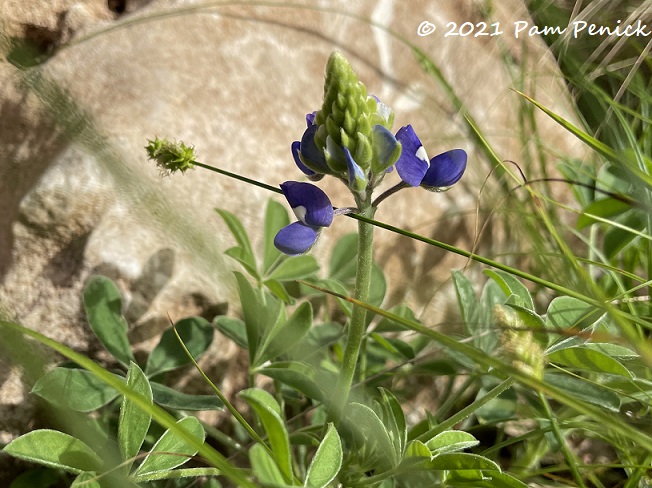
I planted 5 small bluebonnets before the Big Freeze. The deer took two as tribute, leaving me with three, and they came through the deep freeze just fine.
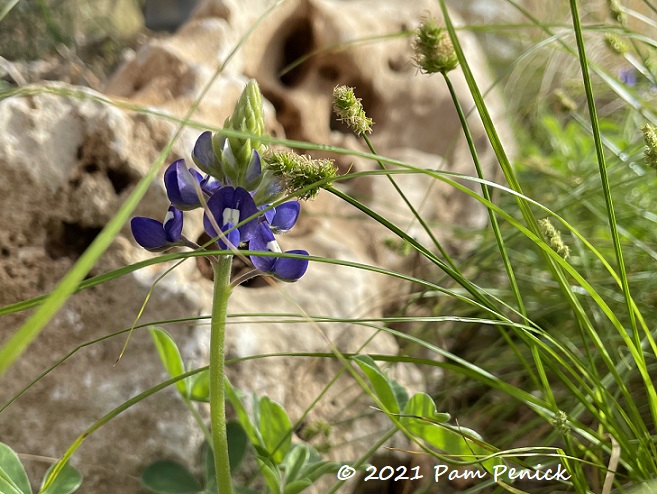
Now they’re blooming, a hopeful sign of spring!
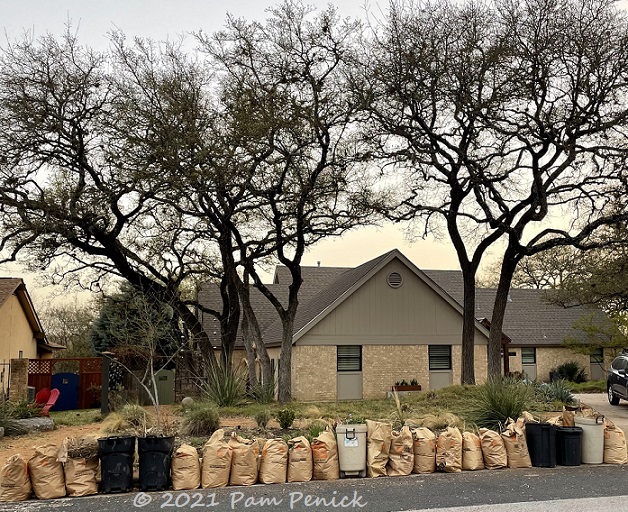
Keeping it real, though, this is how the past couple of weeks have looked: bag after bag after bin of cut-back plants, mushy agave leaves, and live oak leaves, which annually drop in mid-March and came down a couple weeks early this year due to the Big Freeze. Thankfully, the city picks up yard clippings and turns them into compost, so it’s not going to the landfill. All of Austin’s gardens are getting a major haircut this year. Maybe even a buzz cut.
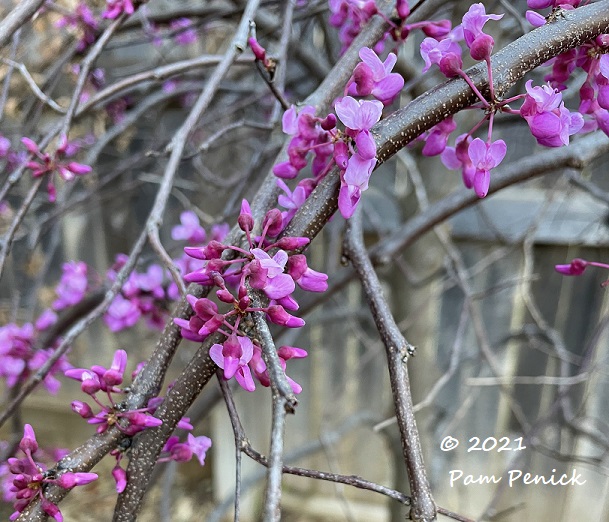
‘Traveller’ weeping redbud is putting on a show in the back garden. Redbuds (and Mexican plums too) are standouts this year without the competition of Texas mountain laurels, which were hit hard by the freeze.
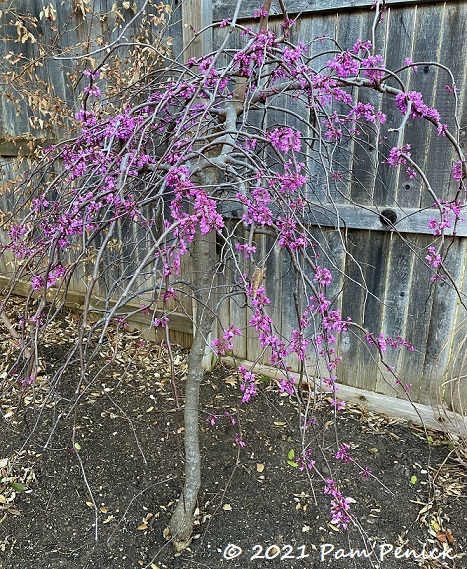
We’re now a month past the freeze, and experts like Neil Sperry (in North Texas) are saying if a plant isn’t showing signs of life by now, it’s probably toast. But I’m still holding onto hope for a few things, like my loropetalums (the brown leaves at left), which show green under the bark when I scratch it. If they don’t re-leaf soon, however, I’ll cut them down and see if I can find replacements this fall. I’m also watching my Mediterranean fan palms and two bamboos, ‘Tiny Fern’ and ‘Alphonse Karr’, for signs of life. Oh, and my big toothless sotol in my steel pipe planter is looking iffy. I already replaced a smaller one in a different planter. Another likely casualty is a big blue nolina in the back garden. I’ve been visiting nurseries daily in the Hunger Games competition to find replacement plants — similar to the Hunger Games competition to find a Covid vaccine. Success on that front, at least!
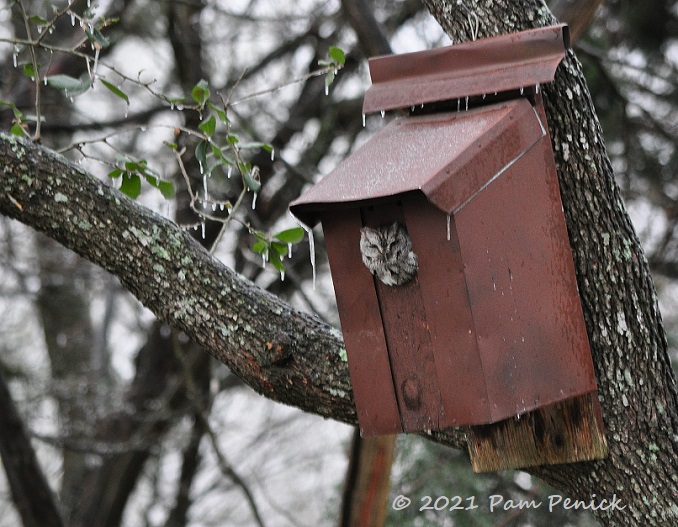
It’s crazy out there, folks. But you already know that. Time to focus on the signs of spring and new life — like the screech owl nesting in our owl box! I took this photo a month ago, in the sleet phase of the Big Freeze, happy to see the owl hunkered down in the box but also a little worried for her because of how cold it got. I’m happy to report that she’s still there, making daily appearances in the doorway. Maybe she’s sitting on a few eggs and we’ll see owlets peeking out in another month or so. Here’s to new beginnings!
__________________________
Digging Deeper
Come learn about gardening and design at Garden Spark! I organize in-person talks by inspiring designers, landscape architects, authors, and gardeners a few times a year in Austin. These are limited-attendance events that sell out quickly, so join the Garden Spark email list to be notified in advance; simply click this link and ask to be added. Season 8 kicks off in fall 2024. Stay tuned for more info!
All material © 2025 by Pam Penick for Digging. Unauthorized reproduction prohibited.


Having lived thru a couple unexpected deep freezes (Sierra Nevada foothills), I think waiting one month is just not long enough. I had woody plants and geraniums and citrus that I was absolutely positive were totally dead surprise me 3 months later with new growth. After a month the plant is still in shock. As the weather moves farther into spring and the ground warms up, you may well be surprised with what comes back. The mushy stuff needs to go but don’t be too hasty with pulling plants up. It’s tough as a gardener because the yard looks awful and you want to clean it up NOW, but go have a cup of tea (or a beer :D) and give it a bit more recovery time.
It’s good to hear about your experience, Kandi, and I’m with you on waiting longer on certain plants — for me, evergreen shrubs and semi-hardy woody perennials like Tecoma, pale pavonia, Mexican honeysuckle, etc. The only plants I’ve pulled so far are mushy succulents, crown-soft nolinas and sotols, and other clearly destroyed woody lilies. But Neil is speaking from decades-long experience with gardening in Texas, so I pay attention to his advice. Here, our soil never freezes, and the ground is warm. We had 70 and 80 F weather right before the deep freeze and immediately afterward. I expect that plays a role in how quickly plants are primed to recover here vs. colder regions.
Neil’s larger point was that damaged shrubs (especially Texas favorites like pittosporum, loropetalum, mahonia, etc.) may have a few sprigs of green at the base, but if they’re not growing well by now, they’re unlikely to recover quickly enough to suit most homeowners. His recommendation was therefore to pull and replace them before all the nursery stock is gone. (Many Texas growers and nurseries lost a lot of their stock.)
I share all this to pass along to other Texas readers what I’ve read. I don’t have personal experience with record-shattering freezes like this, and I am still holding out hope and moving slow with certain of my plants. By summer we’ll know for sure and can make planting plans for fall, and hopefully by then nurseries will be able to stay stocked. Right now it’s a madhouse out there.
And now I’m off to have a cup of tea per your advice and enjoy what’s still alive! 😉
I’m glad to see some positive signs in your garden, Pam. I’ll keep my fingers crossed for your Loropetalum and other plants on the watch list.
Do, please! Mine are tightly crossed too.
Frankly I have things that don’t show strong signs of life until April. Even in a good year. hold on a while longer.
I’m keeping my fingers crossed on the evergreen shrubs that got hit hard. Time will tell.
That line-up of yard debris bags really says it all Pam. I’ll bet the signs of spring are doubly appreciated this year. One must move on -but we all prefer to do it on our terms-not Mother Natures’. She had quite a tantrum in Texas this year. Hope you see a few more signs of life soon !
She sure did, KS. I’m definitely grateful for every sign of spring and sign of life in the garden this year, but it’s not the kind of spring anyone would wish for.
What are your thoughts on the pale pavonia? Any hope? Mine look particularly dead.
I’m watching them anxiously, Mayson, and starting to lose hope.
as if 2021 weren’t already hard enough on the garden, the hail last night. At least the hail was small enough in my neighborhood to not damage the tomatoes and peppers
Right, argh! I think I dodged the hail last night, but I heard from friends who didn’t. What next, we’re saying? Locusts?
Pam:
I seek your advice for my huge Confederate Jazmin vine. It’s definitely alive, as it’s green and blooming at the bottom. It had achieved full-screening status. Should I just trim it, cut it back completely, or let it be? It’s quite depressing to look at “as is.”
It’s good that yours has regrown some leaves and is even blooming at the base! My guess is that the top is dead. It’s probably a safe bet to go ahead and cut the brown off at this point. But if you see any green inside the brown, stop and give it a little more time.
Looks like you got a workout with all those bags, you’re lucky they pick it up, we have to haul ours to the dump, where they also make mulch. I have had jatropha bloom as late as May after a light freeze, so I agree on waiting longer on some plants. Texas gardens will definitely be shorter this year, most of the plants I have blooming are coming up from the base. I will be pickier now about most perennials I plant, should survive drought and freeze! Thanks for encouraging us onward!
We now know which are the plants that can handle a 100-degree temperature range, at least!
Love the Bluebonnets!
They’re always a mood-lifter. The deer took another one yesterday though. Grrr.
Our confederate jasmine covered a good portion of our fence. Ours looked exactly like yours does, Yolanda, and I just couldn’t handle looking at all the dead vines. I just trimmed ours down almost to ground this morning and low and behold there are little bright green shoots coming out. It’ll take forever for it to regrow like it was before, but I’m calling it a win!
Jannelle, thanks for your input. I’m getting there. Cutting it back will be a major undertaking, maybe I’ll approach it like I would eating an elephant??
Thanks for sharing, Janelle. I’m going to trim back my butterfly vine this weekend, which looks the same.
Pam, if you think your garden looks sparse, you should see mine! Still, things are popping up and blooming in my garden, even as a couple of my trunked palms look more iffy by the day.
Ugh, I’m sorry, Peter. Like you, I’m seeing certain plants continue to decline, specifically my toothless sotols.
Those bags…so much work!! I hope things are greening up and making the losses less painful. I hit both BSN and TNG yesterday, and yes, both were crazy! So glad I don’t have to attempt a visit on a weekend. And wouldn’t you know it – as I started to plant a few replacement items (chile pequin, Mexican honeysuckle), I did find the tiniest signs of life at the base of the frozen plants. I’m hoping the larger, established root system will make them bounce back quickly, but we’ll see.
That’s great, Maggie! I’m wondering the same thing: will established root systems allow plants to bounce back more quickly? Neil Sperry says, with sympathy, no, that some plants will not recover, even if they have a little green growth at the bottom right now. But I suppose it just depends on the plant, not to mention location, microclimate, etc. I think the Mexican honeysuckle WILL recover in time. I’m hoping golden thryallis will. I’m seeing new leaves at the base of both. But I’m less sure about things like loropetalum and mahonias.
What about your flax lilies? Any sign of life in them? I have a couple that are sending out really small green shoots, but all the rest look as dead as a doornail. I’m getting impatient!
No sign of life on my variegated flax lilies, and from previous experience with hard freezes, I don’t expect them to recover. Even if they live, they will look straggly and bad for at least a couple years. So I’m planning to replace those. There are a few leaves on my ‘Clarity Blue’ dianella, so I might leave that one for now, although it looks pretty bad.
Ugghhhh, okay. Time to rip up and try something new. Thanks!
I’m near Mueller & my flax lilies are coming back slowly!
Sorry to hear about the losses you have had Pam- and hope that you get some nice surprises with things that you thought were gone making a recovery!
Made me chuckle about your deer taking 2 blue bonnets as tribute! 🙂
I know your garden will look amazing again in next to no time!
The deer took a third one yesterday! Down to two now. 🙂
You’ve certainly been through more these past few weeks than most gardeners in a lifetime, but I think patience is going to be your best ally. Like some of the others who have commented, I say play the waiting game and see what miracles nature has in store for you. I’ll be thinking of you and sending lots of “re-growth” vibes your way!
Thanks for the positive vibes, Ellie. Spring makes everything better. The garden is a lot thinner now, but maybe that’ll turn out to be a good thing in unexpected ways.
[…] you hoped to get a replacement before nurseries ran out of stock. Some readers still held out hope when I shared that advice, and they were proved right when some of my plants started showing signs of life after that point. […]